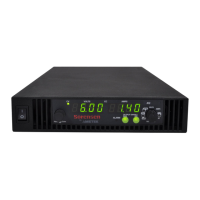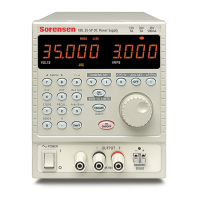Local Operation
3-24 M370430-01 Rev B
The alarm LED will remain illuminated until the alarm is manually
cleared (see “Clearing Triggered and Manual Alarms” on page 3-22) or
by turning the main output on if the alarm has automatically been
cleared.
Alarm Masking
It is possible to completely disable some alarms through the use of the
alarm mask. If an alarm is masked then this masking will prevent it from
registering in the SCPI conditions registers as well as not triggering the
alarm. The alarms that can be masked are identified in Table 3-4 on page
3-21. Setting the bit position (1) of an alarm will result in the alarm
being enabled. Clearing the bit position (0) of an alarm will result in the
alarm being masked/disabled.
For Example:
If you wanted to enable the OTP, Foldback and UVP alarms, you would
take the foldback value of 256 and the UVP value of 1024 to get a mask
of 1280. This is the value you would send with the SCPI command.
Control of the alarm mask is only available using the SCPI command.
The SCPI command (s) for these instructions are:
[:]SYSTem[<channel>]:PROTection:MASK
The mask command takes a single parameter made up of the sum of the
values for the alarms that are to be masked. See Table 3-5 for the alarm
values associated with each maskable alarm.
Table 3-5 Alarm Mask Bit Positions
Over Temperature Protection (OTP)
Over Temperature Protection (OTP) Slave
(1700W only)
Under Voltage Protection (UVP)
The SCPI command (s) for these instructions are:
[:]SYSTem[<channel>]:PROTection:MASK

